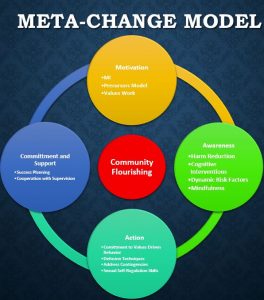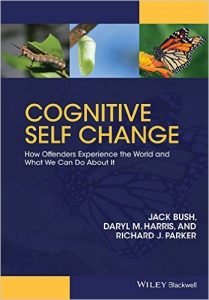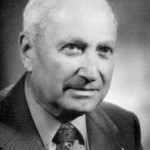 “I didn’t do it, I’m innocent” are the words that end the path towards treatment for most sex offenders. Hearing these words during a program screening often means that an inmate is not eligible for treatment, which has meant that many offenders return to the community with no treatment to address their sexual criminogenic risk factors. Historically, sex offenders have been required to admit to some or all aspects of their offending behavior in order to participate in treatment. It makes intuitive sense, after all, that offenders should have to take full responsibility for their offending behavior, feel some degree of remorse, and recognize their impact on victims in order to be considered rehabilitated, right?
“I didn’t do it, I’m innocent” are the words that end the path towards treatment for most sex offenders. Hearing these words during a program screening often means that an inmate is not eligible for treatment, which has meant that many offenders return to the community with no treatment to address their sexual criminogenic risk factors. Historically, sex offenders have been required to admit to some or all aspects of their offending behavior in order to participate in treatment. It makes intuitive sense, after all, that offenders should have to take full responsibility for their offending behavior, feel some degree of remorse, and recognize their impact on victims in order to be considered rehabilitated, right?
Enter Dr. Liam Marshall, an internationally recognized psychologist who specializes in sex offender treatment and research, and who recently provided a day long training to DOC staff on working with offenders who deny their offenses. Dr. Marshall highlighted the belief that overcoming denial before criminogenic risk factors can be addressed simply hasn’t been supported by the best, most empirically rigorous research available. He reviewed a number of meta-analyses investigating sexual recidivism and recidivism rates from his own treatment program for deniers to support the claim that treated deniers have lower recidivism rates than untreated admitters and untreated deniers.
These are controversial findings to say the least. From victims, to victim advocates, and further across other stakeholders, rehabilitation just seems more intuitively real when an inmate appears remorseful and takes full responsibility for their offending behavior, even if the data does not support this assumption. Dr. Marshall also addressed this disconnect in his training and recounted conversations he has had with victims and victim advocates. By his account, efforts towards preventing future victims have been received well, even if that means past victims do not get the full degree of closure that might be afforded to them by knowing that an offender is remorseful and transparent about his offending behavior.
While this information challenges traditional assumptions about sex offender treatment, it also supports pathways to develop programming to prevent future victims. The DOC Sex Offender Treatment Program has developed its own pilot programming, named Moving Forward, to reduce the impact of criminogenic risk factors for high risk sex offenders who deny their offending behavior. The program is 14 weeks and targets antisocial attitudes and behavior and high risk sexual attitudes and behavior, without relying on traditional assumptions about therapy prerequisites. The Moving Forward program is not a substitute for treatment- it is a last chance effort to address criminogenic risk for those offenders who fall within programming and sentence structure limitations. In the event that an inmate admits to offending behavior he will be transferred into a standard treatment group.

The Moving Forward program is currently in the pilot stage of development. The initial group of offenders is now moving through their 8th week of programming and feedback from offenders this far has reflected positive attitudes about the program. Some offenders expressed eagerness about programming to help them achieve their goals for a prosocial lifestyle without the required conditions of the standard treatment model. The program utilizes evidence-based practices to increase participant’s ability and willingness to self-regulate in accordance with community expectations.
The development of this pilot is in line with cutting edge practices being undertaken by Washington State’s Sex Offender Treatment Program. “Since the program’s inception in 1988, we have continued to incorporate research and evidence, driving best practices and contributing to the body of knowledge in a relatively niche area of specialized treatment.” Program Director Jeff Landon is “excited by the growth and expansion of the SOTP under the Offender Change Division over the past several years. Not only are we piloting creative and effective ways to engage a population who would otherwise not typically receive treatment for their sexual behavior problems, we are also developing co-occurring treatment for sex offender with high needs in substance abuse, investing heavily in staff development through specialized trainings and comprehensive Motivational Interviewing training with a coaching component.”
“Moving Forward is a comprehensive and well organized model developed by our own Dr. Whetstine-Richel through collaboration with a highly respected researcher and practitioner” says Landon. “Moving Forward is the culmination of a vision I’ve had since I interviewed to become the program director more than two years ago.” “Overall the SOTP is well positioned for success and advancement. You’d be hard pressed to find a more talented, dedicated and hard working group of people working with some of the most difficult and traumatic content imaginable. It is because of their commitment to community safety that we are able to grow and adapt to meet the needs of those who are at highest risk to reoffend” says Landon.


 L’une des principales difficultés que doivent surmonter les organismes correctionnels de la collectivité est de trouver une façon d’appliquer les connaissances acquises sur les approches efficaces à leurs pratiques quotidiennes. Le respect des principes du risque, des besoins et de la réceptivité en matière de prestation de services est menacé par diverses questions liées à la conception, à la mise en oeuvre et à l’évaluation des programmes dont il faut tenir compte dans le « monde réel » de la surveillance communautaire. L’Initiative de formation stratégique en surveillance communautaire (IFSSC), qui a été élaborée à titre de modèle de prestation de services et de programme de formation sur sa mise en oeuvre, visait à aider les agents de probation à appliquer ces principes à leurs pratiques régulières de surveillance. Dans le présent rapport, nous décrivons les difficultés et les problèmes dont il faut tenir compte quand vient le temps d’appliquer le résultat des recherches au monde réel de la surveillance communautaire dans lequel vivent les agents de probation et nous évaluons les efforts qui ont été déployés pour surmonter ces difficultés dans le cadre de l’IFSSC. Fermement enraciné dans les principes du risque, des besoins et de la réceptivité, le modèle de surveillance proposé dans l’IFSSC met l’accent sur les interventions des agents qui visent à faciliter les changements prosociaux d’attitudes et de cognitions chez les délinquants qui présentent un risque de récidive qui va de modéré à élevé. Pour assurer l’intégrité des services et le maintien des compétences des agents de probation, l’IFSSC permet non seulement à ces derniers de suivre une formation initiale de trois jours portant sur le modèle et les interventions cognitivo-comportementales de base, mais elle offre également une surveillance clinique continue. L’affectation aléatoire des cas des délinquants aux agents de probation et l’observation directe de leurs interactions avec les délinquants sont les composantes clés de l’évaluation de cette initiative. Les résultats préliminaires révèlent que l’IFSSC a eu une incidence considérable sur l’amélioration de la capacité des agents de probation à utiliser les pratiques correctionnelles de base efficaces.
L’une des principales difficultés que doivent surmonter les organismes correctionnels de la collectivité est de trouver une façon d’appliquer les connaissances acquises sur les approches efficaces à leurs pratiques quotidiennes. Le respect des principes du risque, des besoins et de la réceptivité en matière de prestation de services est menacé par diverses questions liées à la conception, à la mise en oeuvre et à l’évaluation des programmes dont il faut tenir compte dans le « monde réel » de la surveillance communautaire. L’Initiative de formation stratégique en surveillance communautaire (IFSSC), qui a été élaborée à titre de modèle de prestation de services et de programme de formation sur sa mise en oeuvre, visait à aider les agents de probation à appliquer ces principes à leurs pratiques régulières de surveillance. Dans le présent rapport, nous décrivons les difficultés et les problèmes dont il faut tenir compte quand vient le temps d’appliquer le résultat des recherches au monde réel de la surveillance communautaire dans lequel vivent les agents de probation et nous évaluons les efforts qui ont été déployés pour surmonter ces difficultés dans le cadre de l’IFSSC. Fermement enraciné dans les principes du risque, des besoins et de la réceptivité, le modèle de surveillance proposé dans l’IFSSC met l’accent sur les interventions des agents qui visent à faciliter les changements prosociaux d’attitudes et de cognitions chez les délinquants qui présentent un risque de récidive qui va de modéré à élevé. Pour assurer l’intégrité des services et le maintien des compétences des agents de probation, l’IFSSC permet non seulement à ces derniers de suivre une formation initiale de trois jours portant sur le modèle et les interventions cognitivo-comportementales de base, mais elle offre également une surveillance clinique continue. L’affectation aléatoire des cas des délinquants aux agents de probation et l’observation directe de leurs interactions avec les délinquants sont les composantes clés de l’évaluation de cette initiative. Les résultats préliminaires révèlent que l’IFSSC a eu une incidence considérable sur l’amélioration de la capacité des agents de probation à utiliser les pratiques correctionnelles de base efficaces. The Correctional Management Institute of Texas (CMIT) at Sam Houston State University, in collaboration with the authors of Decision Points, provide an evidence-based correctional program constructed to address offender risk, needs, and responsivity.
The Correctional Management Institute of Texas (CMIT) at Sam Houston State University, in collaboration with the authors of Decision Points, provide an evidence-based correctional program constructed to address offender risk, needs, and responsivity.


